Cultivating Lettuce: Optimal Growth Environments
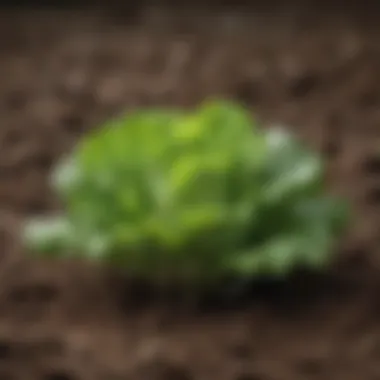

Intro
Growing lettuce can be both an art and a science. To achieve optimal growth, it is essential to understand the various environments and conditions that influence lettuce development. This guide outlines key factors such as soil composition, container selections, and climatic considerations. Novice and experienced gardeners alike can benefit from this information, as it helps cultivate healthier and more abundant lettuce crops. By examining traditional methods and introducing innovative practices, gardeners can optimize their yield and quality.
Understanding how to create the best growth environment for lettuce is critical. The results can significantly affect flavor, texture, and overall plant vitality. Various elements come into play, from pH levels to nutrient availability. Therefore, environmental factors must be scrutinized closely.
In writing this article, the focus will be on providing actionable insights to enhance gardening practices. The sections to follow will explore in detail the components that make for effective lettuce cultivation.
Understanding Lettuce as a Crop
Lettuce is a significant crop for many gardeners and farmers. Understanding its attributes is crucial for successful cultivation. Lettuce thrives in a variety of conditions, making it accessible for both novice gardeners and seasoned horticulturists. This plant's rapid growth cycle means that growers can have multiple harvests throughout the year, offering both economic and nutritional advantages.
Botanical Characteristics of Lettuce
Lettuce belongs to the Asteraceae family. Its scientific name is Lactuca sativa. There are several varieties, including romaine, butterhead, and leaf lettuce. Lettuce can vary in color and shape, which affects its use in culinary applications. The plant typically grows in a rosette formation. Its leaves are delicate, which makes them sensitive to environmental stressors, such as extreme temperatures. Understanding these characteristics helps the gardener to select the right type of lettuce for their specific growing conditions.
Nutritional Benefits
Lettuce is not just a staple in salads; it offers numerous nutritional benefits. It is low in calories, making it an excellent choice for those seeking to maintain a healthy weight. Key nutrients found in lettuce include vitamins A, C, and K. These vitamins contribute to good vision, immune function, and bone health. Additionally, lettuce has dietary fiber, which aids in digestion. Including fresh lettuce in one's diet can enhance overall well-being. This aspect of lettuce cultivation contributes to the motivation for growing it at home.
"Growing lettuce at home not only provides a fresh source of nutrients but also promotes sustainable eating practices."
The significance of understanding lettuce as a crop extends beyond its cultivation. The nutritional value and versatility of this leafy green make it an essential addition to both gardens and diets.
The Importance of Growing Medium
Growing medium plays a crucial role in successful lettuce cultivation. The right medium not only supports plant growth but also provides essential nutrients, aeration, and moisture retention. Lettuce, in particular, has delicate roots that need a well-balanced growing environment. Understanding how to select and manage the medium can significantly influence the yield and quality of your lettuce.
When discussing the growing medium, it is essential to consider soil composition and other factors that contribute to healthy lettuce plants.
Soil Composition Essentials
The Role of Organic Matter
Organic matter is a fundamental component of any soil mix. It includes decomposed plant material, animal remains, and other organic substrates. The key characteristic of organic matter is its capacity to enhance soil fertility. It increases the soil's ability to retain moisture and provides a slow release of nutrients that are crucial for healthy plant growth.
Choosing organic matter enriches the soil structure and promotes beneficial microbial activity. This is a significant advantage in lettuce cultivation, as microbes help break down nutrients, making them available for plant uptake. However, one must be cautious; too much organic material can lead to over-saturation, which may harm the roots.
Soil pH Levels
Soil pH is another critical factor in determining the suitability of a growing medium for lettuce. Lettuce prefers a slightly acidic to neutral pH level, usually between 6.0 and 7.0. Maintaining these levels ensures that essential nutrients like nitrogen, phosphorus, and potassium are readily available to the plant.
If the pH level is too high or too low, nutrient availability can be compromised, leading to deficiencies that affect growth and yield. Testing soil pH regularly allows for adjustments using amendments as needed. This careful maintenance enhances the overall success of lettuce cultivation.
Choosing the Right Soil Mix
Commercial Potting Mixes
Commercial potting mixes are designed specifically for container gardening. These mixes often contain a blend of peat, perlite, and other materials that enhance drainage and aeration. A key characteristic is their ability to provide a balanced environment for roots.
They are popular because they are convenient and reliable, often containing added fertilizers that boost plant growth. However, they may differ in quality, so selecting a reputable brand is essential. Some mixes can retain too much moisture or become compacted over time, potentially leading to issues with root health.
DIY Soil Blends
Creating a DIY soil blend allows for customization based on specific gardening conditions. This approach can mix components such as garden soil, compost, peat moss, and perlite. A notable characteristic of DIY blends is the ability to tailor the mixture to personal preferences and local environmental conditions.
While DIY blends can be cost-effective and satisfying to create, they require more knowledge and effort to ensure a balanced composition. Improperly mixed ingredients can lead to inadequate drainage or nutrient imbalances. This can hinder the growth potential of lettuce if not monitored closely.
Containers for Growing Lettuce
Choosing the right container for growing lettuce is fundamental for successful cultivation. Containers provide gardeners with the flexibility to grow lettuce in various environments, whether it’s in a backyard, on a balcony, or even indoors. They allow for effective soil management and can help control various growth factors like moisture retention, nutrients, and pests. The importance of containers lies in their ability to adapt to different spaces while ensuring optimal growth conditions for lettuce.
Benefits of Container Gardening
Container gardening offers numerous advantages, especially for those with limited space. One key benefit is the ability to better control the growing environment. By using containers, growers can select specific soils that cater to lettuce requirements, ensuring optimal pH and nutrient levels. Additionally, containers provide mobility. This ability to move plants can protect them from harsh weather conditions and pests by relocating them as needed. Furthermore, container gardening can reduce soil-borne pests and diseases, leading to healthier plants.
Another benefit is the opportunity for extended growing seasons. Gardeners can start their lettuce earlier in the spring and continue growing later into the fall by insulating containers or bringing them indoors. This makes container gardening an efficient choice for dedicated gardeners.
Types of Containers
When it comes to container gardening, there are several options available, each with its own benefits and characteristics.
Traditional Pots
Traditional pots are the most commonly used containers for growing lettuce. Made from materials such as clay, plastic, or ceramic, these pots are available in various sizes and shapes.
One key characteristic of traditional pots is their versatility. They are suitable for various plant types, not just lettuce. This makes them a preferred choice for many gardeners. The porous nature of clay pots allows for better airflow to the roots, which can prevent root rot. However, they require more frequent watering since they may dry out faster than plastic alternatives.


Raised Beds
Raised beds are another popular option for lettuce cultivation. These are elevated planting areas framed by wood, stone, or other materials.
A significant advantage of raised beds is the improved drainage they provide. This characteristic is especially beneficial in areas with heavy clay soil that retains water. Raised beds also allow for better soil control, providing an opportunity to mix in organic matter and tailor the soil mixture specifically for lettuce growth.
One downside is that they may require more effort to set up and can be costlier than traditional pots, depending on the materials used.
Hydroponic Systems
Hydroponic systems represent an innovative method for growing lettuce without soil. They utilize nutrient-rich water solutions to provide essential minerals directly to the plants' roots.
One notable advantage is the efficiency of water use. Hydroponic gardening typically uses less water than traditional methods, making it an attractive option for those in areas with limited water resources. Additionally, by eliminating soil, the risk of soil-borne pests and diseases is significantly reduced.
However, hydroponic systems can require more initial investment and careful monitoring of nutrient levels and pH. They may not be ideal for beginners who are new to gardening.
In summary, there are various container options available for growing lettuce. Each has unique characteristics that cater to different gardening needs. Whether it is the flexibility of traditional pots, the efficiency of raised beds, or the innovation of hydroponic systems, the right choice significantly impacts overall growth and health of lettuce.
Climate and Environmental Considerations
Understanding the role of climate and environmental factors in the cultivation of lettuce is crucial for achieving optimum growth. Lettuce, being a cool-season crop, thrives within a specific temperature range and light conditions. The ability to manage these elements effectively can significantly influence the quality and yield of the harvest. Given that lettuce cultivation spans various geographical locations, it is pertinent to consider local climate conditions alongside the specific varietal needs of the crop.
When addressing climate and environmental considerations, gardeners must focus on the interplay between temperature and light. Both factors directly impact the growth cycles of lettuce plants, from germination to maturity. Ensuring optimal conditions can lead to robust plants that resist diseases and pests, ultimately contributing to a successful growing experience.
Temperature Requirements for Lettuce
Lettuce prefers cooler temperatures, with the ideal range being between 60°F (15°C) and 70°F (21°C). Temperatures exceeding 75°F (24°C) can cause stress to the plants, leading to bolting and bitterness. It's essential to monitor the temperature, especially during the summer months, as these fluctuations can affect growth stages dramatically.
During the initial germination phase, soil temperatures should stay around 65°F (18°C). If the soil is too warm, it can inhibit the germination process. On the other hand, temperatures below 40°F (4°C) may also slow down or halt growth. Therefore, adopting methods like shade cloths or row covers during hot days can help in mitigating high temperature impacts.
"Temperature control is not just about comfort but success. Managing it effectively will ensure you get healthy lettuce plants."
Light Conditions: Natural vs. Artificial
Light is another critical factor in growing lettuce. Lettuce requires approximately 12 to 16 hours of light per day for optimal growth. When considering natural light, positioning the plants to get adequate sunlight is vital. South-facing locations are often ideal, though tulled growth can occur if exposed to direct sunlight during the hottest part of the day.
In cases where natural sunlight is not sufficient, growers often turn to artificial lighting solutions. LED grow lights are efficient options that provide the necessary spectrum for healthy growth. When using artificial lights, it is crucial to maintain a suitable distance from the plants to avoid overheating.
In summary, both temperature and light conditions play an integral part in the successful cultivation of lettuce. By paying close attention to these environmental variables, gardeners can ensure their lettuce crops are healthy, vibrant, and productive.
Watering Strategies for Optimal Growth
Watering is a critical component in the cultivation of lettuce, influencing its overall health and yield. The right watering strategy not only ensures that the plants receive adequate moisture but also prevents problems such as root rot and nutrient leaching. Understanding the delicate balance is essential for gardeners at any level.
Understanding Water Needs of Lettuce
Lettuce requires consistent moisture to grow effectively. The plant thrives in soil that is neither too dry nor overly saturated. Understanding its water needs contributes to optimal growth and helps prevent stress, which can affect flavor and texture.
Surface vs. Deep Watering
Surface watering involves applying water directly to the top layer of soil, allowing moisture to penetrate gradually. On the other hand, deep watering encourages the roots to seek moisture deeper in the soil profile. Surface watering is easy and quick. It allows for monitoring the immediate moisture level. Deep watering encourages root development. It promotes a stronger, more resilient plant. However, deep watering can be more time-consuming and may require different techniques to implement effectively.
How to Check Soil Moisture
Checking soil moisture is vital for preventing over or under-watering. A common method is to stick a finger into the soil up to the second knuckle. If the soil feels dry at this depth, it is time to water. Monitoring moisture helps maintain healthy lettuce growth. Additionally, a moisture meter can provide more accurate readings. These tools are user-friendly and effective for both novice and experienced gardeners. This practice avoids the common misstep of relying solely on a fixed watering schedule, tailoring the approach to the specific needs of the plants.
Irrigation Methods
Different irrigation methods can significantly impact lettuce growth and water efficiency. Selecting the right system can make a distinctive difference in the health of the plants and the convenience provided to the gardener.
Drip Irrigation
Drip irrigation delivers water directly to the plant roots through a system of tubing and emitters. This method minimizes water wastage while ensuring that the plants receive moisture consistently. It is especially beneficial in areas with limited rainfall or for those wanting to conserve water. Drip systems can be customized based on plant spacing and light needs. While the initial setup may require investment and planning, the long-term benefits can outweigh these factors by providing efficient water usage.
Rainwater Collection
Rainwater collection is an eco-friendly irrigation method. It involves directing rainwater into storage systems, which can later be used for watering gardens. This method capitalizes on natural resources, reducing dependence on municipal water supply. Collecting rainwater can also lessen runoff, which may carry away important nutrients from the soil. However, it requires some setup and maintenance to ensure the system functions properly. The quality of collected rainwater should also be considered to avoid contaminants.
Nutrient Management
Nutrient management is crucial for the successful cultivation of lettuce. This process involves understanding and providing the necessary nutrients that lettuce plants require to grow optimally. By ensuring that plants receive the right balance of nutrients, gardeners can enhance growth, improve yield, and boost overall crop quality. Nutrient management is not just about applying fertilizers; it also includes understanding the type of growth stage, soil characteristics, and the specific needs of lettuce as a crop.
The benefits of effective nutrient management are manifold. Well-fed plants grow faster and are more resilient to pests and diseases. This can lead to reduced wastage and increased harvests. Additionally, managing nutrients properly helps in maintaining the ecological balance of the soil, supporting beneficial microorganisms that contribute to a healthy growing environment.
The Role of Fertilizers
Fertilizers play a fundamental role in nutrient management. They provide the essential nutrients that might be lacking in the soil. There are two primary types of fertilizers: chemical and organic. Each type has its own specific aspects and contributions to growth management in lettuce cultivation.
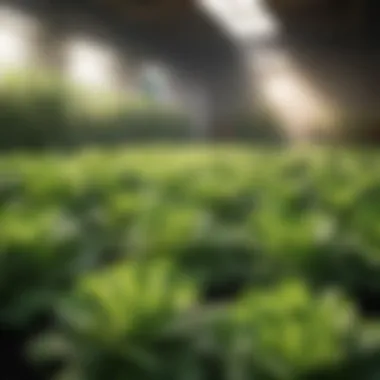
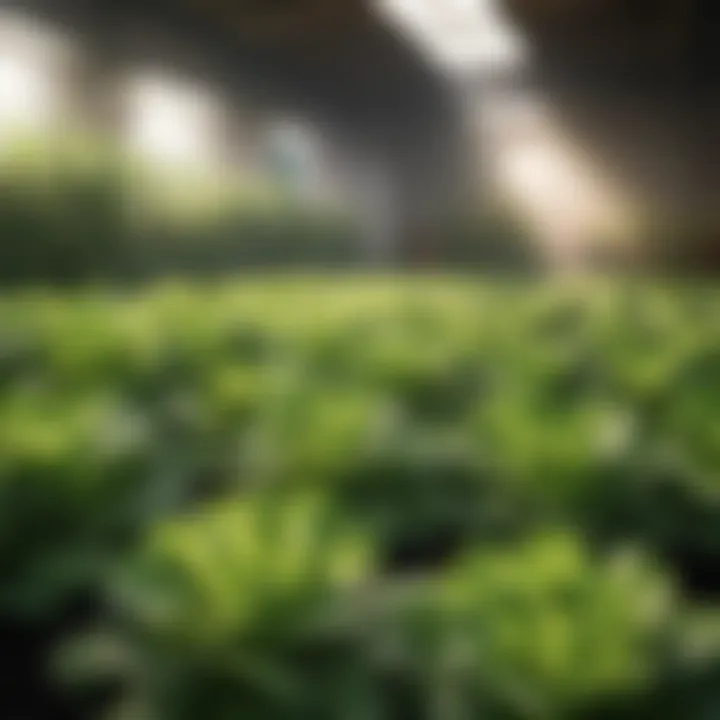
Chemical vs. Organic Fertilizers
Chemical fertilizers are synthetic and designed to deliver specific nutrients rapidly to the plants. They often contain higher concentrations of nutrients like nitrogen, phosphorus, and potassium, which are vital for plant growth. The key characteristic of chemical fertilizers is their immediacy in providing nutrients, which can lead to quick plant responses. However, they can lead to soil degradation and may disrupt the natural microbial ecosystem if used excessively.
On the other hand, organic fertilizers are derived from natural sources, such as composts, manure, and plant materials. One unique feature of organic fertilizers is their slow-release nature. This means they provide nutrients over a longer period, improving soil structure and promoting microbial activity. Organic fertilizers are considered beneficial by many because they contribute to long-term soil health and sustainability, though they may take longer to show effects compared to their chemical counterparts.
Before choosing between chemical or organic options, gardeners should consider factors like soil health, environmental impact, and specific growth requirements of lettuce.
Applying Nutrients at Different Growth Stages
Nutrient requirements for lettuce vary throughout its various growth stages. Understanding these stages is important for effective nutrient application.
- Seedling Stage: Young lettuce plants need balanced nutrients with a focus on nitrogen for healthy foliage growth. A diluted fertilizer solution can help boost early growth.
- Vegetative Stage: During this stage, the plant requires more nitrogen to support leaf development. Regular, small applications of fertilizers can keep the nutrients available without overwriting the balance.
- Maturity Stage: As lettuce approaches maturity, the focus shifts to potassium and phosphorus, essential for improving the quality of the heads. Nutrient application should taper off as harvesting approaches.
By closely monitoring nutrient levels and adjusting feedings according to the growth stage, gardeners can ensure healthy lettuce plants and maximize yield.
Effective nutrient management leads to robust lettuce plants and larger harvests, promoting sustainability in cultivation.
Pest and Disease Management
Pest and disease management is a crucial aspect when cultivating lettuce. The challenges posed by pests and diseases can significantly impact the yield and quality of lettuce crops. By understanding the common pests and diseases, gardeners can implement strategies to mitigate their effects. This will not only promote healthier growth but also improve the sustainability of lettuce farming.
Common Pests Affecting Lettuce
Common pests such as aphids, slugs, and caterpillars are often found in lettuce crops.
- Aphids are small insects that suck the sap from lettuce leaves, which can weaken the plant and lead to reduced yields. They reproduce quickly, so early detection and control are vital.
- Slugs feed on the tender leaves of young lettuce plants, creating irregular holes in the leaves, which can make them unappealing and reduce their market value.
- Caterpillars, particularly the cutworm, can cause significant damage as they often cut the plants at the base, leading to wilting or death.
To effectively manage these pests, gardeners can use a combination of physical barriers like row covers and natural predators such as ladybugs. Additionally, integrated pest management practices can help in monitoring and controlling these pests.
Diseases to Watch For
Diseases pose another risk to lettuce production that can lead to significant crop losses. Awareness and early detection are essential in preventing the spread of these diseases.
Damping Off
Damping off is a soil-borne disease caused by fungal pathogens that attack seedlings, causing them to rot and collapse. It is especially prevalent in moist conditions, making it a critical concern for indoor and outdoor growers during wet seasons.
The key characteristic of damping off is its ability to affect young plants at the seedling stage, resulting in drastic losses and affecting overall crop viability. The disease is a common issue in poorly drained or overwatered soils.
Advantages of addressing damping off include healthier seedling establishment and increased overall crop resilience. By using well-draining soil mixes and avoiding overcrowding, gardeners can reduce the occurrence of this disease.
Downy Mildew
Downy mildew is a fungal infection characterized by the appearance of yellow spots on the upper side of leaves, with grayish, fuzzy growth underneath. This disease thrives in cool, humid environments, making it a notable concern in many lettuce-growing regions.
The key characteristic of downy mildew is its rapid spread under favorable conditions, which can lead to substantial crop damage. It is particularly detrimental because it not only reduces yield but can also render the crop unsellable due to aesthetic damage.
To combat downy mildew, it is crucial to maintain proper air circulation and avoid wetting the foliage during watering. Additionally, the use of resistant lettuce varieties can be an effective strategy for managing this disease.
Timely intervention and proactive measures in pest and disease management are essential to ensure healthy growth and maximize yield in lettuce cultivation.
Harvesting Techniques
Harvesting techniques play a crucial role in the overall success of lettuce cultivation. Proper harvesting not only affects the immediate yield but also contributes to the quality and shelf-life of the produce. Understanding the methods of harvesting leads to better management of resources and maximizes the benefits gained from growing lettuce.
Timing Your Harvest
Knowing when to harvest is paramount for achieving optimal flavor and texture in lettuce. The timing varies depending on the specific variety of lettuce grown and the intended use. Leaf lettuces, for example, can be harvested early for a more tender yield, while head lettuces need more time to develop full size. Growers should monitor the growth stages closely to ensure the best results. Harvesting at peak freshness enhances taste and nutritional value.
Key indicators for timing include:
- Leaf Size: Leaves should be a suitable size for consumption or market.
- Color: The vibrant color indicates ripeness and freshness.
- Texture: Leaves should feel firm rather than wilting or soft.
- Taste Test: A small taste can confirm flavor readiness.
Methods of Harvesting Lettuce
Methods of harvesting can greatly influence the final quality of lettuce. There are two primary approaches: cutting and pulling. Each has its characteristics that cater to different types of lettuce and harvesting goals.
Cutting vs. Pulling
Cutting and pulling are methods that differ in execution and outcome.
Cutting is a popular choice for gourmet practices as it maintains the integrity of the plant. By cutting the stems just above the soil, you encourage potential regrowth. This is beneficial for leaf varieties like Butterhead or Romaine, as multiple harvests can result from this method.
Pulling involves uprooting the whole plant. This method is traditionally used for head varieties like Iceberg. While it guarantees a complete harvest, it does not allow for regrowth. The unique feature of pulling is the immediate retrieval of the entire lettuce head, streamlining the harvest process, but it limits future crops.
Post-Harvest Handling
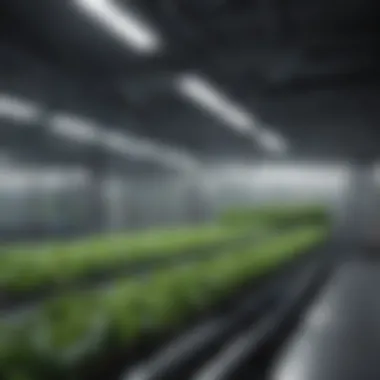
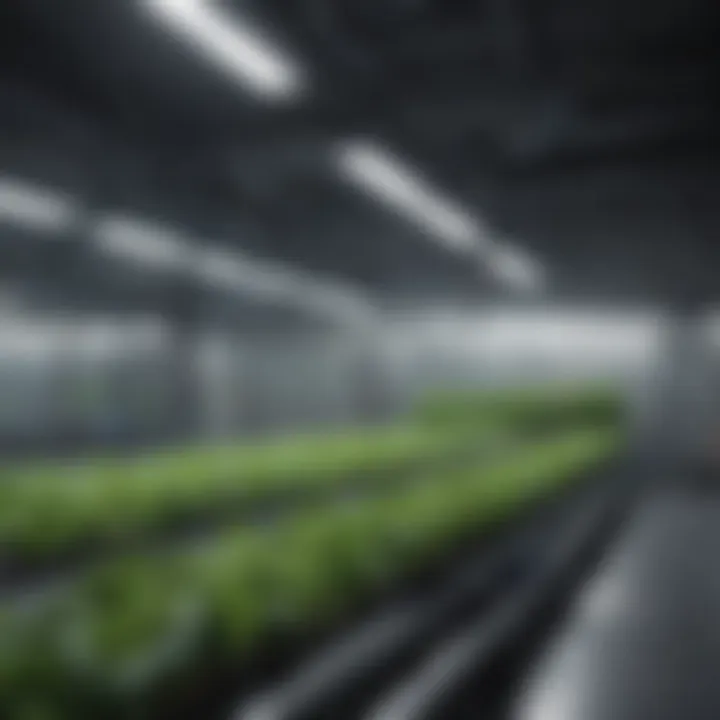
Post-harvest handling is fundamental to maintaining quality after harvesting. This phase impacts how long the lettuce remains fresh and appealing for consumers. Proper handling techniques ensure minimal damage during the transition from garden to table.
Key aspects of post-harvest handling include:
- Cooling the Produce: Quickly cooling helps preserve crispness and delay spoilage.
- Washing: Gentle washing removes residues, enhancing presentation and safety.
- Packaging: Use breathable materials to allow for airflow while protecting the lettuce.
The crucial characteristic of post-harvest handling is maintaining the product's quality while preparing it for market or consumption. Effective handling leads to a better shelf-life and satisfied customers. However, each step in this process must be handled with care, as mishandling can result in a decline in quality.
Remember, the ultimate goal of harvesting techniques is to maximize yield while ensuring high-quality produce that meets market standards and customer expectations.
Seasonal Considerations for Lettuce Cultivation
Understanding how different seasons affect lettuce growth is essential for any gardener. Lettuce thrives in specific temperature ranges and can be sensitive to extreme weather conditions. By recognizing the seasonal nuances, gardeners can optimize their growing strategies to enhance yield and quality. Cool seasons generally provide favorable conditions for lettuce, while summer demands more adaptive strategies. It's crucial to learn what works best for lettuce during varying times of the year to ensure successful cultivation.
Growing Lettuce in Cool Weather
Cool weather is conducive to lettuce cultivation, especially for varieties such as iceberg, romaine, and butterhead. Lettuce prefers temperatures between 60 to 70°F. When grown in cool weather, lettuce develops a sweeter flavor and tender texture since the heat of summer can cause bitterness and bolting.
Some recommendations for growing lettuce in cooler temperatures include:
- Choosing the Right Varieties: Certain lettuce types are bred specifically for cooler growing conditions. Select varieties that can withstand light frosts but can also perform well as the weather warms.
- Timing Planting Carefully: Start sowing seeds early in the spring or in the late summer for a fall harvest. This timing allows the lettuce to mature during the cooler parts of the year.
- Using Row Covers: Employing row covers can insulate plants during unexpected cold snaps. This tactic keeps soil and air temperatures consistent, fostering optimal growth.
Utilizing cool temperatures beneficially not only ensures a good harvest but also enhances flavor and quality of the crop.
Strategies for Summer Lettuce
Growing lettuce in summer poses unique challenges due to higher temperatures, which can stress plants and lead to poor yields. However, with strategic planning and adaptive techniques, lettuce can still be successfully cultivated in warmer months.
Consider the following strategies for summer lettuce:
- Select Heat-Resistant Varieties: Look for varieties that are bred for heat tolerance. Options like butterhead and some hybrid types are suitable for higher temperatures.
- Timing is Key: Plant during cooler parts of the season, such as early mornings or late evenings, to help plants avoid the worst heat.
- Provide Shade: Use shade cloths or plant taller crops around lettuce to shield it from direct sunlight during the hottest parts of the day. This technique keeps temperature down and reduces stress on the plants.
- Optimize Watering Techniques: Watering in the morning allows the plants to absorb moisture before the heat of the day. Employing drip irrigation can ensure consistent moisture without waterlogging the soil.
- Evaluate Soil Quality: Make sure the soil is rich in organic matter to retain moisture. Mulching can also help maintain soil temperature and moisture levels.
Adapting to these summer considerations will help maintain good growth and enhance the overall quality of the lettuce crop.
"Timing your planting and knowing your varieties are essential to successful lettuce growth through seasonal changes."
Through seasonal awareness and strategic adaptability, gardeners can effectively manage and cultivate lettuce throughout the year.
Innovative Techniques in Lettuce Cultivation
Innovative techniques play a crucial role in modern lettuce cultivation. As agricultural challenges rise due to climate change, scarcity of resources, and increasing demand for fresh produce, adopting these advanced methods becomes essential for gardeners. These techniques not only optimize space and resources but also enhance growth rates and yield quality. By focusing on unique systems like vertical gardening and aquaponics, growers can produce lettuce that is healthier and requires less space than traditional methods.
Vertical Gardening for Lettuce
Vertical gardening refers to the practice of growing plants in vertical spaces to maximize limited area. This technique is increasingly favored by urban gardeners who face space constraints. For lettuce cultivation, vertical gardens offer significant advantages.
- Space Efficiency: Vertical gardening allows for the cultivation of multiple lettuce plants in a compact area. Towers, shelves, or wall-mounted systems can hold numerous plants, making it feasible to grow more in less space.
- Ease of Access: Plants grown vertically are often easier to tend to, allowing gardeners to monitor growth and conditions more easily.
- Improved Air Circulation: By elevating plants, vertical gardens facilitate better air flow, reducing risks of fungal diseases and enhancing overall plant health.
However, there are considerations to keep in mind. Light exposure may vary depending on the setup and location. Careful arrangement is necessary to ensure that all plants receive adequate light. Also, watering requires careful attention. Water must be delivered evenly to all levels of the vertical structure to avoid dry spots.
Aquaponics Systems
Aquaponics combines aquaculture—a method of cultivating fish—with hydroponics, which involves growing plants in water without soil. This systems produces fish waste that serves as organic fertilizer for the lettuce, while the plants help filter and purify the water for the fish. This closed-loop system has several benefits for lettuce cultivation.
- Resource Efficiency: Aquaponics uses significantly less water than traditional growing methods. The closed system recirculates water, minimizing waste while ensuring that both fish and plants thrive.
- Organic Growth Conditions: Since fish waste provides essential nutrients, lettuce cultivated in aquaponic systems can be grown without synthetic fertilizers. This results in produce that is often more flavorful and healthier for consumers.
- Sustainable Method: Aquaponics contributes to sustainable food production by reducing dependence on soil and conserving water. Additionally, the system can be adapted to local conditions, making it suitable for various climates.
Nonetheless, the setup requires a good understanding of both aquaculture and hydroponics. Balancing the needs of fish with plant growth necessitates careful attention to detail. It is essential to monitor pH levels, temperature, and nutrient content regularly to achieve successful results.
"Aquaponics offers a sustainable approach to farming that appeals to both value-conscious consumers and eco-aware local communities."
By embracing these innovative techniques, gardeners can maximize their lettuce yields while minimizing resource use. These methods are not just a trend, but a viable path toward sustainable urban agriculture, catering to both individual and communal needs.
Closure: Best Practices for Growing Lettuce
In any comprehensive guide about cultivating lettuce, the conclusion serves a vital role. It summarizes the critical elements discussed throughout the article while reiterating the importance of each practice for successful growth. Recognizing best practices is essential for gardeners wishing to optimize their yields and enhance the quality of lettuce they produce.
To cultivate lettuce effectively, several key practices stand out. These include understanding soil composition, maintaining appropriate moisture levels, and ensuring adequate sunlight. A gardener's commitment to these fundamentals will in large part determine their success.
Furthermore, the benefits of mastering these practices are multifold. Not only will they lead to a more plentiful harvest, but they can also reduce the risk of pests and diseases. Healthy plants result from attentive care, and this attentiveness pays dividends in the quality of the lettuce.
Given the diverse conditions in which lettuce can be grown, it is crucial for gardeners to assess their specific environments. Factors such as climate, container choices, and watering strategies should all be tailored to suit individual situations. By doing so, one can maximize the benefits provided by the natural environment and tweak human interventions accordingly.
Summarizing Key Takeaways
- Soil Quality Matters: A balanced mix of nutrients and organic content is essential for healthy growth.
- Watering Wisely: Understanding the water needs of lettuce ensures that plants do not suffer from drought or excess moisture.
- Light Requirements: Both natural and artificial light must be harnessed effectively, depending on the growing conditions.
- Ongoing Pest Management: Keeping an eye out for pests and diseases can save late-season crops from being compromised.
- Harvest Timing: Knowing when to harvest impacts the taste and nutritional value of lettuce.
"A successful garden is a reflection of the effort put into understanding its needs."
Encouraging Ongoing Learning and Experimentation
The world of gardening, particularly in regards to lettuce cultivation, is always evolving. The sharing of experiences and knowledge among gardeners can lead to new insights. Engaging with community platforms such as Reddit or gardening forums can provide a space for ongoing learning.
Moreover, experimentation should not be viewed as daunting. Trying different soil mixes, testing various irrigation methods, or planting at different times of the year can yield surprising results. Novel approaches, such as vertical gardening or hydroponic systems, offer exciting opportunities for those willing to explore beyond traditional methods.
Noting that every gardener’s experience is unique, each individual should document their findings and share them within their networks, whether that be through social media platforms like Facebook or local gardening clubs. By fostering a culture of curiosity, gardeners can continually enhance their skills and knowledge, ultimately leading to improved practices and sustainable growth.







